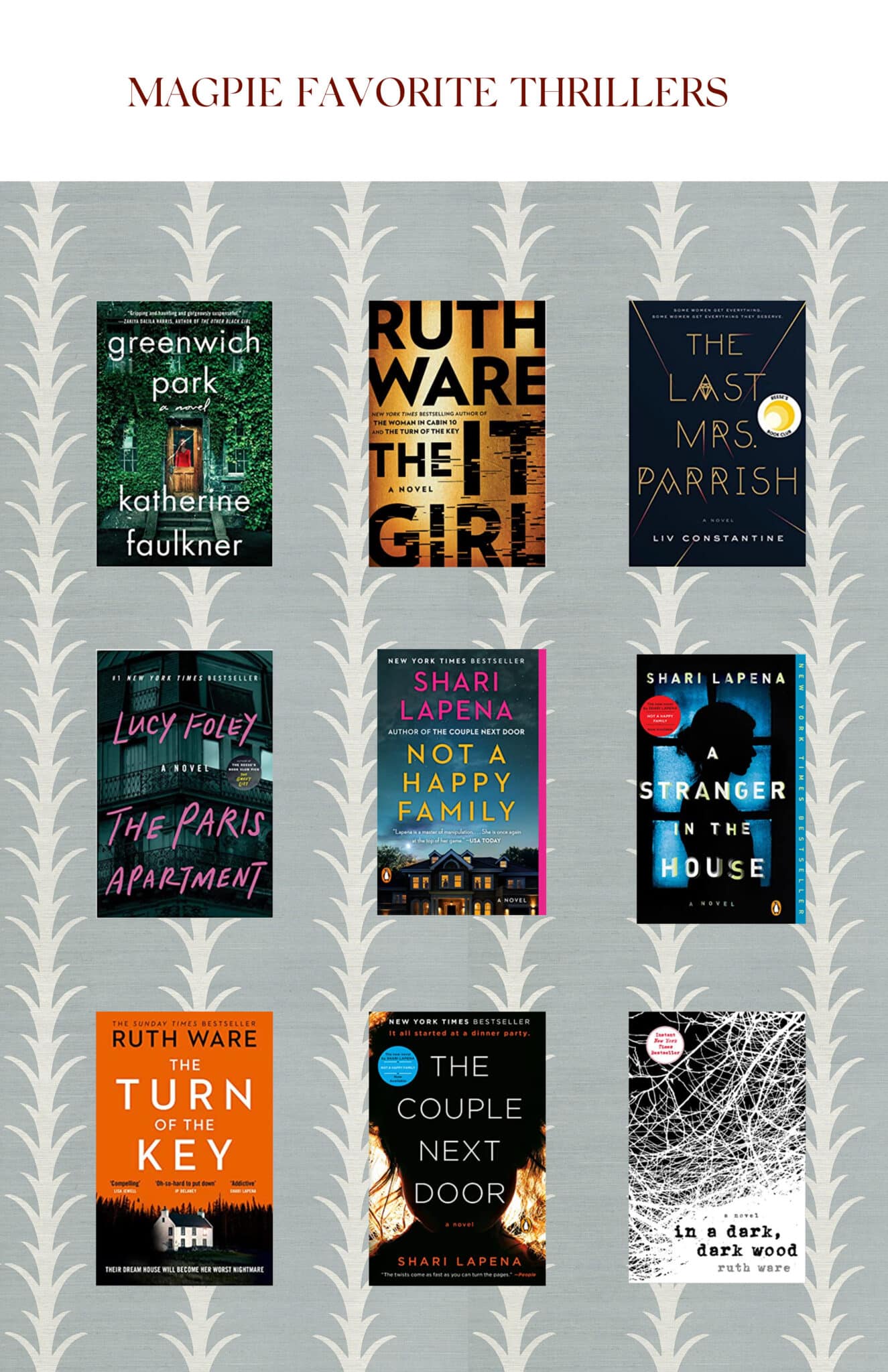I have written elsewhere about my love for the modern thriller. One reason for my interest in this genre is my perception of its relationship to literary history. At the University of Virginia, I took a course called “Gothic Spaces” that examined the representation of “place” in Gothic novels, positing that many of the genre’s physical motifs — hidden stairwells, crumbling walls, haunted castles, deadlocked attics — communicated psychological subtexts in significant ways. I read the contemporary thriller as a modern manifestation of the Gothic mode as I learned it at Virginia. So many modern thrillers foreground physical edifices — think The Paris Apartment, The Turn of the Key, Greenwich Park, In a Dark, Dark Wood, The Woman in Cabin 10 — and nearly all of those spaces are private homes. There is a sense in these novels that horrific things don’t happen “out in the world” but in the privacy of our own homes. In these novels, homes are entrapments, walls of mirrors, spaces that should feel safe but aren’t, places where we learn, in shock, that the people we married are not who we thought they were. There are corpses buried in the foundation (Greenwich Park, Not a Happy Family), there are near-dead bodies in the attic (The Paris Apartment), and — almost invariably — there are secrets to the ownership of these homes that prove harrowing. Beware the blissful domestic scene, these novels seem to chant — you don’t know what ills it conceals. And — don’t get trapped in your own home!
There is so much to contemplate in this problematization of the domestic space across these novels. Perhaps most obviously, this narrative convention interrogates the convention of marriage, in which “the home and hearth” serves as its easy metonymy. By this I mean that these books invite us to ponder questions of financial independence for women, marriage and even “family” as a potentially problematic social construct, and gender roles writ large. I especially feel these tensions in Shari La Pena’s books, in which we are often ensconced in a happy neighborhood on the outskirts of a city only to find that the spouse, or the couple next door, has skeletons in his/their closet that upset and distort suburban bliss. In several of these novels, too, we find husbands who are architects (Greenwich Park, Turn of the Key), and their role in the creation of spaces that ultimately trap or terrorize the female protagonists is telling. I think a Feminist reading of these texts would prove fascinating, though I am much less schooled in that literary lens, having favored “close reading” and “textualist” approaches to literature in my former academic pursuits. Still, there is so much meat on the bone to contemplate, even for those of us without the contextual crutches.
Setting aside the conjuring of physical space in these novels, though, I wanted to comment on one other interesting parallel between Gothic novels of the 18th and 19th centuries and the ones being published today under the auspices of the “modern thriller.” In so many of the originals (thinking particularly of Castle of Otranto), we find female protagonists who faint under conditions of extreme stress and shock. This convention feels irritatingly outmoded to the modern woman. But these “fainting scenes” had the interesting narrative result of creating confusion and lapse in the text — that is, we might not know what actually happened in a scene because the protagonist fell unconscious. In the contemporary thriller, authors are using alcohol and drug abuse to achieve the same effect. How many times do we encounter a shaky-handed protagonist pour herself too much wine and then “rub her temples, trying to remember what happened”? How often are we led to wonder whether a character was drugged in a scene? The use of substances in these scenes introduces interesting narrative disruptions — loopholes in which we scramble to figure out what might have happened. Ultimately, these lapses contribute to the hermeneutics of thriller-reading. But I find the shift between the fainting of the Gothic protagonist and the substance abuse of the modern thriller’s protagonist telling. We are no longer to read the woman’s frail body as a cause for narrative distress; it is now the introduction of an alien substance (occasionally against the woman’s will) that builds intrigue.
Would love to hear your thoughts on these observations!
Shop My Favorite Thrillers.

Post-Scripts.
+There are many ways, and reasons, to read.
+On getting out of a reading rut.
+Literary footholds.\
+Magpie will be undergoing a major glow up in the next week or two, and the site may be temporarily unavailable at some point during this time. We will be back up and running with a new look (but the same far-flung mix of posts, toggling between the freighted and the frivolous) in short order! I have wanted to shorten the name from TheFashionMagpie to Magpie for years now and cannot wait to introduce you to the new nest. In the meantime, should you encounter it, please pardon the dust.
Shopping Break.
+If you like the Ulla J. Elsie dress but it’s a bit out of budget, this OPT is a fantastic sub for under $200. Both are perfection for fall occasions (even Thanksgiving).
+Going to do a full roundup of fall/winter boots soon, but these are such a great pick for pairing with all these fabulous fall floral dresses.
+Drawn to these faux-leather boot cuts — can you even imagine with a chunky neutral knit?
+The Home Edit just launched some great organizational pieces at Walmart — this 8-pack of clear organizing bins is under $25! You know I love these for cabinet/under-sink/craft/closet storage. I also thought this hot tool organizer was clever.
+Ordering myself a new floor mirror and cannot decide between this one I’ve been eyeing forever or this simpler one in the perfect shade of Magpie blue. For an eye-popping splurge, check out the ones from Fleur Home. Wowwww.
+For some reason the Ganni coat so many of us have been eyeing is like $100 less here than anywhere else on the internet?
+Elizabeth Strout readers rejoice: her newest installment with the Lucy Barton character will be released on Sep 22.
+Easy and adorable fall weekend outfit for your toddler: LE turtlenecks beneath LE overalls. I will say the overalls run very narrow — I find the Osh Kosh ones are a better fit for little toddler boys still hanging onto their baby fat. Micro has definitely thinned out over the past year (weep) and I have a hunch he’ll fit better in the LEs now, at age 3, then he did when he was still a little pudge at 2.
+PSA — found Lilly shifts for littles on sale for $29 here in infant sizes and here in girl sizes. Buy ahead for next summer!
+Alice Walk just released the cutest reversible quilted coat.
+Burgundy velvet heels for under $150!
+I haven’t shopped at Hanna Andersson in awhile but they have some intriguing, classic basics for boys out — this sweatshirt, these cords.



I don’t read a lot of thrillers, but I DID read Wilkie Collins’ The Woman in White last year for a book club and was gripped by desire to read a good modernization of the story. The book relies for so much of its suspense on the absence of technologies we take for granted today–so female characters are trapped under the power of the villain and don’t have any way to get out for help, deliver messages, verify dates, etc. — I really want to see someone clever take the basic story and make it work in a very different technological milieu.
You mention fainting/drugs above, and there is a classic delirium-for-unknown-weeks passage in The Woman in White, though if my memory is correct I think she may actually have been drugged too?–but I’m also/especially interested in the way technological differences change narrative needs from gothic to modern thriller.
This is SO fascinating, and I love the idea (challenge?) of a rewrite. Might need to read it myself and contemplate how I’d do it — ha!
Agree with you on the technology piece, especially in the modern thrillers, where they do play a prominent role. There are lots of shaky phone calls and strange text messages and “no service zones” that further erode the sense of stability/security in the novels. As an example, in “Paris Apartment,” the protagonist keeps running out of minutes on her phone and is then unable to navigate in a foreign city. Super interesting!
xx
Love this line of thinking! I recently fell into a deep rabbit hole about the Gothic romance pulp fiction novel- the type that was popular in paperback form in the 1960s-70s and whose covers all feature almost the exact same image: a nighttime scene showing a woman in a flowing dress/robe in the foreground fleeing from a foreboding house/castle/mansion with a single window illuminated in the background. They follow a lot of the same tropes you outline here- the house as a main character, as a threat, as a prison, as a source of psychological torment. I hadn’t made the connection between the modern thriller, but I totally see it!
Love this connection – you’re also making me think of some of the horror movies set in houses (and lots of farm houses) that dominated the 70s and have been having a reprise in recent years. Some similar “problematizations” of the domestic/suburban scenes happening in those.
xx
How interesting! I never thought to compare a fainting scene with an alcohol/drug induced blackout as ways to create an unreliable narrator. But could some of the “fainting” scenes of old actually been drug/alcohol induced as well? Maybe someone over doing it with the restorative brandy? And it wasn’t socially acceptable for a woman to be an alcoholic, or to write about it? Obviously corsets and other restrictive garments had something to do with the fainting as well 🙂 Also, fevers. In old novels and new ones as well (The Thirteenth Tale and The Vanished Days come to mind) characters seem to fall ill from something like being out on a rainy night. I get that a run-down, overworked, stressed person is likely to get sick even today…but being sick and delirious in bed for days with fever did seem a bit of a stretch in modern times. But a handy way to create “missing” hours in which anything could have happened!
Hi! Yes, totally – the trope of “catching a bad cold from traipsing through the rain and becoming deliriously feverish” feels outmoded, but does accomplish a lot from a narrative standpoint. Interesting!!
xx
This is so fascinating
. I haven’t read any of the books mentioned but I was thinking of Mexican Gothic, the Perfect Nanny, and Girl on the Train…that film with Emily Blunt. I am watching the show The Patient which so far has kept me interested. The Lost Daughter isn’t a thriller but more a feminist book in that it discusses the challenges of motherhood and offers a viewpoint which is different than most. Think Arsenic & Old Lace, not really a thriller but the horrors take place in a house which appears to be in a normal neighbourhood where 2 seemingly normal Aunt’s live. There’s more to be seen if we just look closer.
Hi Michelle – Yes! I’d forgotten about “Girl on the Train,” but that was really the first one that hooked me in this genre and I feel like it was genre-defining, too. There are a lot of definitional elements of that book that I see play out in a lot of the later-published books listed here. Thanks for these other recs – hadn’t heard of them!
xx
I love your thoughts on this topic! I’m particularly fascinated by your thoughts on the connection between the “fainting scenes” and the alcohol/drug abuse in modern novels. Thank you for sharing.
Have you read any books by Riley Sager? You may enjoy Home Before Dark or Lock Every Door. I preorder all of his books and have loved all of them except for his newest release.
Hi Allison! Of course – the more I wrote about this genre, the more I realized its richness. Glad this resonated with you. I have not read Riley Sager yet! I just added Lock Every Door to my TBR list!
xx